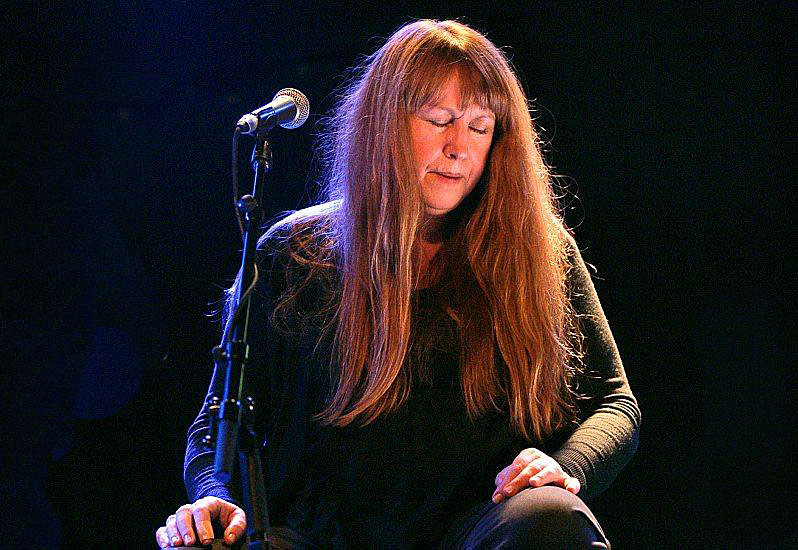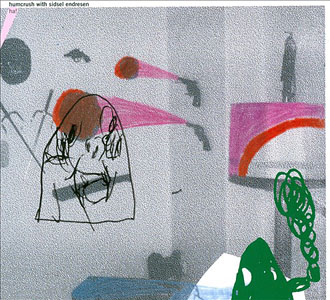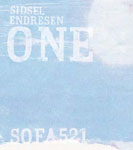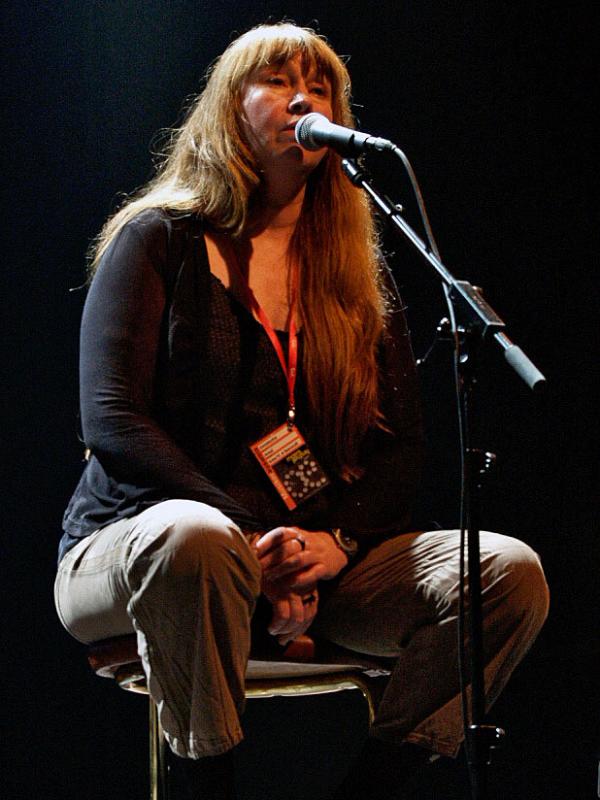Home » Jazz Articles » Interview » Sidsel Endresen: The Place to Be
Sidsel Endresen: The Place to Be

Ha! (Rune Grammofon, 2011), her recently released collaboration with Humcrush, reveals one of the many facets of an artist who is exploring the hidden potential of her own voice to address our sensitiveness in a most direct way. Together with the musicians belonging to the Nordic jazz tradition, Endresen has been engaged, for more than three decades, in the interactive pursuit of new channels destined to transform an ethereal form of artistic expression into pure emotion.
All About Jazz: What is your voice made of?
Sidsel Endresen: I think that a voice is more like a channel. This is what I feel after working with it for so many years. It is the muscle that connects me with the world; an instrument I can use for that purpose. The other thing is that, being part of the body, it is very connected to my thought processes. There's no filtering between, which is a good thing but, on the other hand, it can become very private, and I don't want that to happen. I want to be personal but not private. There's a fine line there. I also want to be able to move my perspective; to be able to move and look at my voice from a meta perspective in order to see how close I am to fulfilling a musical idea. It is like an instrument but without the material filter all other instruments have. There is nothing in-between. For me, the voice is like having a very happy marriage between your intuitive musical self and your intellect. They don't function well separately, and merging them takes a lot of time. Whenever I research something new I am more cerebral than intuitive, but then when I spend enough time working on these new parameters, it kind of clicks in where it belongs. In other words, being spontaneous requires a lot of pre-work.
AAJ: Was it a focused kind of effort?
SE: Not really, now that I look back at it. When I was a younger musician I worked within very different musical genres, and with different parameters and structures without having any kind of pre-conceived concept. Later on as I started working more methodically, particularly with the sound modules, the basis was already there, through my continuous work with more straight material. So I had a deeply grounded departure point in straight, pre-organized material. This has proven to be all-important for me in my current work with free-improvisation.
AAJ: Did you decide, early on, that you were going to become a singer, or was it rather an accidental course of events?
SE: There was always a lot of music in my home. My father was a classical violin player and my mother an amateur opera singer. I was around 14 when my father gave me a guitar and I started learning to play it, and started making songs. Probably around that time, I recognized that I could carry a song. I don't think I ever decided to become a singer; it was rather coincidental. It happened through people I met when I was very young, who were working with music. And it just grew from there, slowly. I didn't really consider my singing as a possible career until I was about 24 or 25. Before that I was into many things and possibilities. I studied social anthropology and English literature. I actually never studied music formally. I was involved, as a side-project, in a couple of bands—and we started doing some gigs in Oslo, and soon I found myself a part of the music scene in Oslo. No strategy here and, thus, a true surprise that so much happened from these local gigs.
 AAJ: When did you start writing music? Was it the result of a maturing process or just pure inspiration?
AAJ: When did you start writing music? Was it the result of a maturing process or just pure inspiration? SE: It was definitely the result of a maturing process. At first I was making very sentimental songs with the few basic chord sequences I knew, and then, when I started working with professional musicians, my level of ambition grew and, although I continued making music, I realized how much I didn't know, so I didn't want to show my writing anymore. There were many years when I only wrote the poetry, the lyrics, because I had been doing that since I was very young, I felt I had a strong voice there. In fact I stopped making music for many years because the musicians I collaborated with at that time wrote better music for my lyrics than I did.
AAJ: Did it have an inhibiting effect on you?
SE: Not really. It was rather more like facing reality. In the mid-eighties I started making music again. More based on my own musical ideas. In the meantime I had been gradually moving towards improvised music. So, you see, all my musical processes have been just that: process-driven and very gradual. Even now, as we speak, I find myself right in the middle of another learning process. It is a continuous challenge—and, therefore, a good place to be.
AAJ: The thread leading to the Nordic line of heritage in your music is quite visible.
 From left: Stian Westerhus, Sidsel Endresen
From left: Stian Westerhus, Sidsel EndresenSE: Strangely enough my main inspiration when I started writing music was with singer-songwriters like Joni Mitchell—who were coming from the American folk tradition, and not from the Nordic one—but I think if you live in Norway, you are exposed to folk music all the time. It is one of the countries where traditional folk music is highly regarded and you hear it all the time on the radio. I grew up with my father listening to folk music and, in particular, fiddle music on the radio. It was always there. So I think that it is, indeed, a bit of my heritage.
AAJ: What's striking is the cohabitation of the Nordic tradition with the most experimental musical approaches and techniques. Where do they meet? What is the point of disjunction?
SE: As I said, my main influences were Anglo-American and, as I grew up in England (I lived there for eight years), I was very much into this genre—and it is still a point of departure for me in all I do. But when it came to exploring the voice, my main motive was the wish to do other things with it than simply carrying a song. I wanted to work improvisationally, and more instrumentally with the voice, so that I could be a true force in the way the music evolved. I wanted to be a real part of defining the form, texture and total sound. I wanted to have the freedom to move in and out of foreground/background. I have always been very frustrated with the role of vocal improvisation within mainstream jazz. Sonically it is always a copy of the sound of the trumpet or the sax, and thus automatically adopting the phrasings of these instruments. But, importantly, many of my greatest musical heroes and heroines are mainstream jazz singers and instrumentalists.
AAJ: Why was that? Was it the technique?
SE: I think it was the mannerisms of jazz vocals, which I found a bit too night-clubby, too smoky, too languid. It is wonderful when it is genuine but for me to even contemplate emulating this was a no. Felt like acting. I've been through the Real Book and standards, and done my time studying jazz harmonies and more, but I never found myself there. I think I rather have a stronger affinity for pop, country and folksingers. So, from an improvisational point of view, I looked elsewhere. I got into ethnic music forms from all around the world, from which I found a great source of inspiration because of the great variety of uses and functions of the voice. But this as a source of inspiration only. These traditional forms would take a lifetime to fully understand or handle—so you let it stream, you let it go through you. There is something with these textures, and the way these voices move, which attracts me enormously.
So that was the first kind of research I had done, if you can call it that. I was spending 12 hours a day, for long periods of time, working with the voice, recording it, working down to phonetics, to sound cells, and trying to turn them into musical objects, something that could communicate with other musicians and other people as well. It is a long process. But I find that even my most experimental, more sonic voice work is based on my work with songs. The work I was doing for the first ten years was mainly pre-organized melodic material. So it is not like becoming, all of a sudden, a completely different person. It is all very connected, through time and experience.
AAJ: Nevertheless, your voice has a suave quality. Do you see yourself as a lyrical singer?
 SE: I really try to achieve a happy marriage between my technical/cerebral musical self and my intuitive musical self. I always work very concretely when I rehearse or research—and when performing, I never focus on the "personal," or on my feelings. On the contrary, I think one's own feelings can be a real quagmire; it is not interesting. What is interesting is the music—in which I am just a channel. Ever since I started singing, I have been very aware that my focus has always been on things like rhythmic parameters, phonetics, phrasing and form. Like how you shape a vowel or how you make a marriage of words and music. My focus was always more on all things musical than on the psychological content or the literary content of the text. I believe that the basic material (words and music) take care of themselves—and that if you overestimate your role as interpreter, you will kill it. And the same now, when I work more sonically and improvised, my focus is on fields of energy, timing, beauty, harshness, speed and density, and so my technique is all about feeding the basic idea. Any catering to the wish to fill the music with "personal touches" or any other such strategic perfumes—will ultimately drop you into a very porridge-like landscape, and will become a swamp that sucks you in and strangles you—and the music.
SE: I really try to achieve a happy marriage between my technical/cerebral musical self and my intuitive musical self. I always work very concretely when I rehearse or research—and when performing, I never focus on the "personal," or on my feelings. On the contrary, I think one's own feelings can be a real quagmire; it is not interesting. What is interesting is the music—in which I am just a channel. Ever since I started singing, I have been very aware that my focus has always been on things like rhythmic parameters, phonetics, phrasing and form. Like how you shape a vowel or how you make a marriage of words and music. My focus was always more on all things musical than on the psychological content or the literary content of the text. I believe that the basic material (words and music) take care of themselves—and that if you overestimate your role as interpreter, you will kill it. And the same now, when I work more sonically and improvised, my focus is on fields of energy, timing, beauty, harshness, speed and density, and so my technique is all about feeding the basic idea. Any catering to the wish to fill the music with "personal touches" or any other such strategic perfumes—will ultimately drop you into a very porridge-like landscape, and will become a swamp that sucks you in and strangles you—and the music.  AAJ: Your voice covers a very wide range of expression, from songs of sheer lyricism to the most daring experimental endeavors. Is there a sonic environment you can identify with the most right now?
AAJ: Your voice covers a very wide range of expression, from songs of sheer lyricism to the most daring experimental endeavors. Is there a sonic environment you can identify with the most right now? SE: It is a matter of affinity and stage development that help you synergize with the others. That's what attracts me: when you don't know what is going to come out of any collaboration. It is not connected to any particular instrument, it is mainly connected to the way people play and the sounds they produce. For example, I love the incredible roughness and wonderful and intuitive timing of [guitarist] Stian Westerhus. That is where we meet. I also love the tenderness and total clarity of [live sampler] Jan Bang and the way he organizes his sounds together with his live samples along the way. He is so quick—and such a strong improviser. And then my collaboration with [percussionist] Thomas Strønen and Ståle Storløkken, in Humcrush, is wonderful and totally challenging. Our improvised trio can express a whole range of things: it can go from very sweet to very hysterical and then, again, to very monumental.
AAJ: In your so-called deconstructions, are you testing the expressive possibilities of your voice or rather exploring virgin musical territory?
SE: I think that one aspect of it is, to put it into very simple terms, that I don't like too much of anything. Something, which is too beautiful, or too funky, gets soon to be too much for me. I like to build something and then to break it up because most of the time something else is emerging then. I had been working for so many years with straight material so, at some point, some 15 years ago, I wanted to change that. To work totally improvised is extremely attractive to me because it offers the possibility to create music now, to compose in real-time. And to be in a situation where you have to rely on and activate your total musical knowledge and let go of all your plans and strategies and go into a real dialogue with whomever you are playing with. Sometimes it works, sometimes it doesn't, but it is forever worth trying. It is always the process that interests me and not the product.
AAJ: Is that covering your whole area of expression as a performer and as a composer?
SE: Yes, it does. Because improvisation is a taboo-free zone. It is a very joyful place to be for me musically. I didn't want to work into kind of jazz free-improv setting because there are heaps of definitions there of what is good and what is bad. I am not a puritan when it comes to which form of improvisation I am working with, and that allows me to let things happen; even things which may not belong there but, if you keep doing it long enough, at some point they do start belonging. There are different things happening with the different people I work with and that makes me feel that I am in a good place.
AAJ: Do you see yourself as an exponent of Nordic Jazz?
SE: I am obviously a part of it. It has less to do with the mountains and the fjords than the fact that we are a very small musical community, we know each other, we meet and interact. We have crossed the genre lines years ago and there's been so much of this genre-free mixing that it has influenced all of us along the way, of course. The other thing is that Scandinavia has a quite a different musical culture (of course I know the Norwegian one best). It also has to do with some very important people, like Jan Garbarek and Jon Christensen, who have some laid fundamental groundwork. Jan was the first to merge the Afro-American music with Norwegian elements. People like that are very inspiring.
AAJ: It's remarkable that, along with valuing the musical heritage, you also went out into the world and explored new traditions and techniques. How does that reflect on your music?
SE: Trying to get familiar with other forms of musical expression is not a linear kind of experience. It is not like you find some music in another continent and you go into it. It would take you a lifetime to get to know those forms, so you can't be a dilettante with it. I don't understand Arabic, I don't understand Chinese or Japanese traditional singing, I don't know really what they are doing, but the sounds and the structures are very interesting to me. For me it was opening up all kinds of technical possibilities—what I can actually do with the voice.
AAJ: Are there any future plans you would like to share?
SE: I think there are some future plans out there I may not know about myself, and I am saying this because this is my reality. I hear someone playing, or somebody hears me, and we get in contact—or it is the people I meet and talk to, and then all of a sudden things start happening. I plan to keep my collaboration with Stian Westerhus and with Humcrush, and with Jan Bang and Erik Honoré. I plan to keep on working on my solo concerts and on a solo record; I am doing a live record album with Stian, which is going to come out in 2012 on Rune Grammofon.
Selected Discography
Humcrush/Sidsel Endresen, Ha! (Rune Grammofon, 2011) Jan Bang, ...and poppies from Kandahar (SamadhiSound, 2010) Sidsel Endresen/Jon Hassell, Punkt Live Remixes Vol. 1 (Jazzland, 2008) Punkt, Crime Scenes (Punkt , 2007) Jazzland Community, Jazzland Community (Jazzland , 2007) Sidsel Endresen, One (Sofa Music, 2006) Nils Petter Molvær, er (Universal, 2005) Jon Balke/Batagraf, Statements (ECM, 2005) Sidsel Endresen/Christian Wallumrød/Helge Sten Merriwinkle (Jazzland, 2004) Sidsel Endresen/Bugge Wesseltoft, Out here in there (Jazzland, 2002) Trygve Seim, Different Rivers (ECM, 2001) Sidsel Endresen, Undertow (Jazzland, 2000) Jon Balke, Saturation (Jazzland,1998) Sidsel Endresen/Bugge Wesseltoft, Duplex Ride (ACT, 1998) Sidsel Endresen/Bugge Wesseltoft, Nightsong (ACT, 1994) Sidsel Endresen, Exile (ECM, 1994)
Photo Credits Page 1: Snare Knut Page 2: Jan Hangeland Page 3: Michael Hoefner
< Previous
Behind the Lens With Becky Yee
Next >
Diverted Travels
Comments
Tags
Sidsel Endresen
Interview
Adriana Carcu
Humcrush
Joni Mitchell
Jan Bang
Thomas Strønen
Jan Garbarek
Jon Christensen
For the Love of Jazz
 All About Jazz has been a pillar of jazz since 1995, championing it as an art form and, more importantly, supporting the musicians who create it. Our enduring commitment has made "AAJ" one of the most culturally important websites of its kind, read by hundreds of thousands of fans, musicians and industry figures every month.
All About Jazz has been a pillar of jazz since 1995, championing it as an art form and, more importantly, supporting the musicians who create it. Our enduring commitment has made "AAJ" one of the most culturally important websites of its kind, read by hundreds of thousands of fans, musicians and industry figures every month.






















